Abstract
A study was carried out to determine in-tube evaporation and condensation performance of enhanced heat transfer tubes (EHT) using R410A, with the results being compared to a plain tube. The test tubes considered in the evaluation include: plain, herringbone (HB) and spiral (HX) microgrooves, herringbone dimple (HB/D), and hydrophobic herringbone (HB/HY). Experiments to evaluate the condensation were conducted at a saturation of 318 K, and at 279 K for evaporation. Mass flux (G) ranged between 40 to 230 kg m−2s−1. Condensed vapor mass decreased from 0.8 to 0.2; and the mass of vaporized vapor increases from 0.2 to 0.8; heat flux increased with G. Inlet and outlet two-phase flow patterns at 200 kg m−2s−1 were recorded and analyzed. Enhanced tube heat transfer condensation performance (compared to a plain tube) increased in the range from 40% to 73%. The largest heat transfer increase is produced by the herringbone–dimple tube (HB/D). In addition to providing drainage, the herringbone groove also helps to lift the accumulated condensate to wet the surrounding wall. Evaporation thermal performance of the enhanced tubes are from 4% to 46% larger than that of smooth tube with the best performance being in the hydrophobic herringbone tube (HB/HY). This enhancement can be attributed to an increase in the number of nucleation sites and a larger heat transfer surface area. Evaporation and condensation correlations for heat transfer in smooth tubes is discussed and compared.
1. Introduction
Heat transfer tubes designed with passive surface enhancements can augment the thermal performance of the tube and produce only a small increase to pressure drop. Various enhancements (i.e., micro-fins, corrugated tubes, etc.) have drawn considerable attention for use in a variety of industrial applications (i.e., refrigeration, air conditioning, etc.). According to Webb and Kim [1], 3D enhanced tubes are excellent augmentation choices; the EHT tubes evaluated here include classic enhanced surface tubes and novel 3D enhanced tubes. Enhancement in these tubes is achieved by increasing turbulence, surface area and nucleation sites, producing fluid mixing and secondary flows, and boundary layer interruption.
Wang et al. [2] experimentally studied the heat transfer of dimpled tubes; results indicate that when compared to a smooth tube, enhanced tubes performance increased by 26.9–75% (for ellipsoidal dimpled tubes) and 32.9–92% (spherical dimpled tubes). Ellipsoidal dimples promote an early transition to turbulent single phase flows (with transition at a Reynolds Number (Re) less than 1000). Various other investigators have studied dimpled tubes including: numerical studies by Li et al. [3]; and geometric optimizations by Li et al. [4]. Both studies conclude that 3-D surfaces enhance heat exchanger performance. Vicente et al. [5] completed an analysis of dimpled tubes at low Reynolds Numbers. Additional studies of three-dimensional, dimpled tubes have been reported by Kukulka and Smith [6]; they report thermal performance enhancements of over 500% for enhanced tubes (with dimples); with a transition to turbulent flow occurring at Re values near 1000.
Guo et al. [7] evaluated performance for various smooth and enhanced tubes; they found that the herringbone tube provides a 200–300% performance increase during condensation. Li et al. [8] studied tube-side condensation and evaporation characteristics of structured 3D enhanced tubes. A similar experimental investigation has been performed by Li et al. [9] in order to evaluate the condensation of novel EHT enhanced tubes. Their results indicate the 1EHT tube exhibited the highest performance factors.
Aroonerat and Wongwises [10,11] performed several studies to evaluate the performance of dimpled tubes; in Aroonrat and Wongwises [10], dimple depth was studied and in [11] the performance of dimpled tubes was investigated. They determined that dimpled tube with the deepest dimple produces the largest heat transfer coefficient (HTC). Sarmadian et al. [12] experimentally studied condensation in a dimpled tube and found that dimple tube heat transfer performance is 1.2–2 times the performance found in a plain tube. Additionally their visualizations show that transition from annular to stratified flow are accelerated when using dimple tubes. Shafaee et al. [13] studied saturated flow boiling and found that heat transfer increased when using enhanced tubes. Ayub et al. [14] analyzed EHT tubes and found that EHT tubes produced three times the heat transfer that is found in plain tubes. Guo et al. [7] studied several enhanced tubes in order to evaluate in-tube condensation conditions using R22, R32, and R410A; they found that herringbone tubes provide a 200–300% performance increase when compared to plain tubes. Kukulka et al. [15] compared the performance of heat exchangers designed using the 1EHT tube in a variety of operating conditions (i.e., oil cooler, water-water heat exchanger, falling film heat exchanger, etc.). Additionally, performance was compared to heat exchangers designed using other enhanced heat transfer tubes. In most situations, the three-dimensional, 1EHT tube out-performed the other tubes. Other conditions still need evaluation in order to better understand the advantages of this tube. Kukulka et al. [16] investigated evaporation and condensation heat transfer performance on the outer diameter (OD) of the 1EHT tube surface. Performance enhancement of 54 to 64% is demonstrated for the 1EHT tube; however, the performance of a smooth tube is better than a 1EHT tube under evaporating conditions. Li et al. [9] evaluated micro fin and 3D tubes in order to determine intube condensation characteristics. They found that the HTC of a copper herringbone tube was up to 2.2 times higher than the HTC of a smooth tube; while the performance increase of the 1EHT tube was up to 1.65 times higher. These studies show the potential that 3D enhanced tubes can provide; however, these studies have evaluated the heat transfer performance for the EHT heat transfer tubes over a limited range of conditions, therefore additional conditions/designs need further evaluation.
Rough surface tubes are an effective heat transfer enhancement technique and they are an important research direction to consider. Soontarapiromsook et al. [17] conducted condensation experiments in a plate heat exchanger with R-134a; the purpose of the investigation was to evaluate the effect of surface roughness. They found that increasing surface roughness and G produces an increase to heat transfer; additionally increasing heat flux slightly increases the heat transfer coefficient (HTC) with only a small increase to pressure drop. Wang et al. [18] investigated and compared the pool boiling characteristics of a copper surface with a micro-nano, bi-porous enhancement. They found that this new surface produced better heat transfer performance; this type of enhanced surface can be a significant addition to the design of an enhanced heat transfer tube under boiling conditions.
In the current study, an experimental investigation (see test apparatus in Figure 1) of heat transfer was performed in order to evaluate tube performance during condensation and evaporation. This study consisted of different combinations of enhancement structures than previous studies. Tubes studied here include the EHT—HB/D tube (herringbone grooves with dimples), the EHT—HB/HY tube (herringbone grooves on a hydrophobic surface), the EHT/DIM tube (dimple tube), and the EHT—HX tube (helical grooves). The tubes evaluated in this study were stainless steel, with an outer diameter (OD) of 12.7 mm and ID of 11.5 mm. Surface measurements are provided in Figure 2 with the main geometric parameters of these tubes being provided in Table 1; finally, photographs of their surfaces are given in Figure 3 (please note: the EHT—HB/HY tube surface is a combination of the hydrophobic surface and herringbone surface).
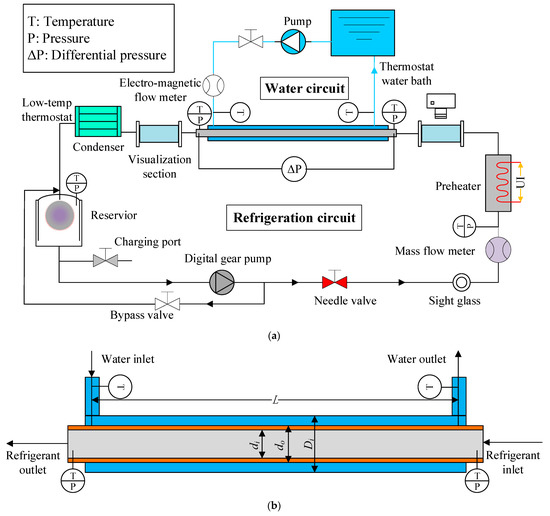
Figure 1.
Schematic of the (a) experimental setup, (b) experimental test section.
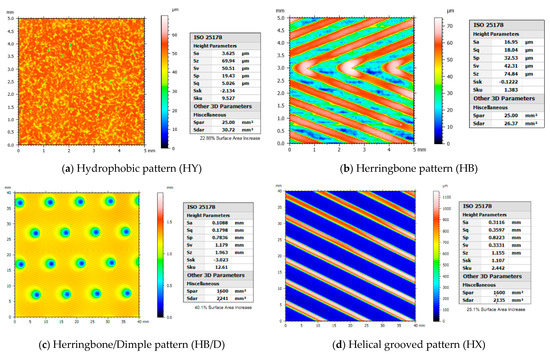
Figure 2.
Surface parameters of the enhancement pattern for the (a) HY tube, (b) HB tube, (c) HB/D tube, and (d) HX tube.

Table 1.
Physical measurements of the enhancement patterns used in the various tubes.

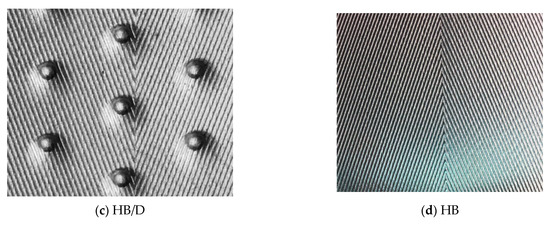
Figure 3.
Photographs of the external surfaces of the heat transfer tubes that were evaluated: (a) HX; (b) HY; (c) HB/D; (d) HB.
2. Procedure
A detailed description of the test apparatus with an uncertainty analysis is provided in Li et al. [9] and Wu et al. [19]. Figure 1a shows the test apparatus made up of a refrigeration circuit and cooling water circuit. The tube evaluated (2 m in length) is inserted into a tube-in-tube heat exchanger (detailed sketch of the test section is shown in Figure 1b).
Evaluation of the enhanced tubes for condensation were performed at 318 K (saturation temperature); mass flux range: 40–240 kg/(m2s); heat flux range: 6.2–30.2 kW/m2; inlet vapor quality of 0.8; outlet vapor quality of 0.2. Evaporation tests were performed at 279 K (saturation temperature); mass flux range: 40–200 kg/(m2s); heat flux range: 8.8–37.1 kW/m2; inlet vapor quality of 0.2; outlet vapor quality of 0.8. Data points were obtained using a custom LabVIEW program; with data being recorded when the whole system achieves a steady state conditions. An analysis of uncertainties for measured and dependent values is conducted to figure out the detailed experimental errors; the results are listed in Table 2.

Table 2.
Accuracy of the various primary and calculated parameters.
3. Theory
Data acquired during the experiment was used to calculate the dependent qualities. An energy balance of the test section was performed to determine the heat transfer:
with cp,w,ts being the water specific heat; mw,ts, mass flow rate of the water; Tw,ts,in, inlet water temperature and Tw,ts,out, outlet water temperature. Inlet vapor quality, xin, is calculated using Equation (5):
with cp,w,pre being the water special heat; mw,pre, mass flow rate of the water; Tw,pre,in, inlet water temperature; Tw,pre,out, outlet water temperature; Tref,pre,in, inlet refrigerant; cp,ref,pre, refrigerant special heat; mref, refrigerant mass flow rate; Tsat saturation temperature of the refrigerant and hlv the latent heat of vaporization for the refrigerant.
Outlet vapor quality, xout is obtained from Equation (6):
Log-mean temperature difference (LMTD) is calculated using:
where Tref,ts,in is the inlet refrigerant temperature and Tref,ts,out the outlet refrigerant temperature. Tubeside heat transfer coefficient, hi, for the refrigerant can be calculated using Equation (8):
where k is the wall thermal conductivity ; ho, shell-side heat transfer coefficient ; Ao, outer surface area; and do, outer diameter. Shell-side heat transfer coefficient for a smooth tube is calculated using the correlation given by Gnielinski [20] in Equation (9) (valid for 3000 < Rew < 5 × 106 and 0.5 < Prw < 2000):
where kw is the water thermal conductivity; dw is the water-side hydraulic diameter; (μbulk/μwall)0.14, is a correction factor for the variation in viscosity; and f, the Fanning friction factor determined using the Petukhov [21] correlation given in Equation (10):
Since the inner and outer surface of the enhanced surface tubes is textured, the Gnielinski correlation (which is used for smooth tubes) needed to be modified using a water-side heat transfer enhancement factor, C. Water-side enhancement factor, C, is the ratio of the heat transfer of the enhanced tubes related to the heat transfer obtained using plain tubes. This was measured (using the Wilson plot) and can be used to correct the Gnielinski correlation. Resistance of the test section is calculated using the following:
where U is the total heat transfer coefficient.
Frictional pressure drop, ΔPf, is calculated from Equation (12):
where ΔPt is the total pressure drop; ΔPg, gravitational pressure drop; ΔPm, momentum pressure drop; ΔPse, sudden enlargement pressure drop; and ΔPsc, sudden contraction pressure drop. Tubes tested in this experiment are horizontally arranged, meaning that ΔPg is equal to zero. Additionally ΔPm is calculated using the following equation:
where G is the mass flux; x, vapor quality; ε, void fraction; ρv, vapor density ; and ρl, liquid density. Void fraction is computed from Rouhani-Axeleeon [22]:
Finally, ΔPse and ΔPsc is given by Equations (15) and (16):
with ζ being the area ratio.
Measurement error and uncertainties were estimated using the computational method based on the error delivery theory (as described by Moffat [23]). Relative uncertainties (UR) are calculated using Equation (17):
where UR, is the estimated uncertainty of the desired variable, ∂R; with an uncertainty, U(Xi); for variables (Xi) and the number of variables (n).
4. Results
4.1. Condensation Correlations
Condensation heat transfer inside a smooth tube can be calculated using the relations presented by Shah et al. [24], Cavallini et al. [25], and Haraguchi et al. [26]; they are introduced and summarized in Figure 4. Cavallini et al. [25] predicts HTCs within the 9% error band. Meanwhile, Shah et al. [24] and Haraguchi et al. [26] predict results within the range −9% and +20%.
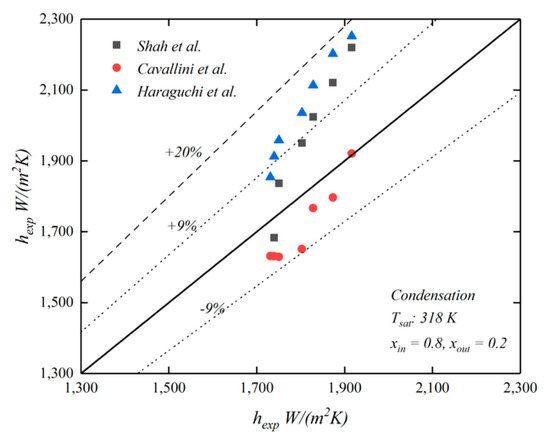
Figure 4.
Comparison of condensation correlations for use with smooth tubes.
4.2. Condensation Heat Transfer Characteristics
Experimental condensation heat transfer results of the five tested tubes are presented in Figure 5. Enhanced tubes with a non-composite surface structure (EHT—HX and EHT—HB) show different HTCs, even though similar grooves make up the surface; the inside HTCs of the EHT—HB tube are higher than the values found in the EHT—HX tube. As an extended surface (in addition to increasing the heat transfer surface area), the helical grooved surface thins the liquid film on the top of the fin and thickens the liquid film in the groove. However, the fin arrangement in the EHT—HB tube was reconstructed so that the liquid flow at the fin convergence will produce a stronger disturbance and produce a larger HTC than the EHT—HX tube. Enhancement (when compared to a smooth tube) of the EHT—HB/D tube [see Figure 2c] ranged from 40 to 74%; with an increase in pressure drop that ranged from 0 to 18%. This enhancement may be attributed to the liquid drainage effects of the herringbone grooves. Additionally, there is also increased turbulence that is produced by the dimples, this leads to increased heat transfer performance.
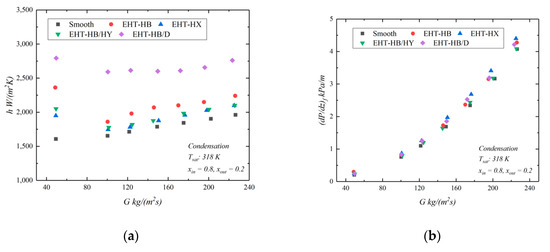
Figure 5.
Tubeside condensation performance comparison (using R410A) of heat transfer tubes as a function of mass flux (G) for: (a) condensation HTC and (b) pressure drop.
Initially the HTC of the enhanced tubes decreased with increasing G; it is virtually constant for 100 kg/(m2s) < G < 200 kg/(m2s); HTC increases slightly for G > 200 kg/(m2s); Li et al. [27] reported similar trends. Kedzierski and Goncalves [28] discuss enhancements that produce eddies at the wall; dimple tubes (studied in this experiment) demonstrate this characteristic. Finally, the micro-scale roughness of the EHT—HB/HY tube seems to reduce the HTC compared to the EHT—HB tube. Pressure drop values of all the tubes exhibit similar values at the same test points, with the exception at G = 50 kg/(m2s) (see Figure 5b). The smallest pressure drop increase was produced by the EHT—HB/HY tube, it ranged from 1.2 to 9.1%.
Figure 6 presents the condensation flow patterns for the tubes at G = 200 kg/(m2s). Inlet flow patterns are similar inside the various tubes (all semi-annular flow—indicating that they have identical operating conditions at the inlet); differences can be seen at the outlet. All the in-tube, outlet flow patterns are stratified wave flows; as can be seen at the interface of the gas-liquid for the EHT—HB/D and EHT—HB tubes, there is more disturbance shown for those tubes than the other configurations; this demonstrates their effect in disturbing the fluid in order to enhance the heat transfer. Diani et al. [29] studied R513A condensation heat transfer inside smooth and microfin tubes; R513A has been proposed as alternative to R134a since it has similar properties and its lower GWP. Future work on the 3D EHT tubes using such refrigerants need to be considered.

Figure 6.
Condensation flow patterns for the tested tubes at the inlet and outlet (G = 200 kg/(m2s).
4.3. Evaporation Correlations
Figure 7 presents a comparison of smooth tube evaporation HTC correlations (Liu and Winterton [30], Fang [31], and Gungor and Winterton [32]) for tubeside flows. Correlations of [30,32] are both based on an assumption that the convective evaporation is composed of forced convection and nucleate boiling. In the Gungor and Winterton correlation, the HTC of those two components is multiplied by their respective coefficients and added together; while in the Liu and Winterton correlation, the final value is obtained by calculating the square root of the forced convection and nucleate boiling components. However, the Fang [31] correlation takes advantage of the dimensionless number, Fa; this is related to the evaporation heat transfer and is used in the prediction of the evaporation heat transfer coefficient. As a result, all three correlations predict the experimental values within an error band of 20%; however, Liu and Winterton [30] produce the most accurate prediction of the evaporation heat transfer coefficients.
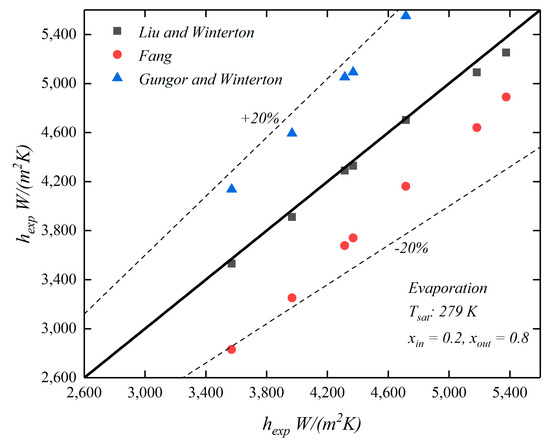
Figure 7.
Comparison of evaporation correlations for use with smooth tubes.
4.4. Evaporation Heat Transfer Characteristics
Figure 8a shows the variation of flow boiling HTC with G; the HTC of the tested tubes are proportional to G. The EHT—HB/D tube has the poorest HTC enhancement; in some cases, the HTC of the dimple tube is lower than a plain tube; much higher heat transfer coefficients (especially for G > 100 kg/(m2s)) are produced by the EHT—HB/HY and EHT—HX tubes. Liquid entrainment produced by the dimples and herringbone grooves in the EHT—HB/D tube produces poor enhancement; the entrainment can prevent the tips of the enhancement from becoming wet. The HB grooves cause the liquid film to lift and the dimples forced the liquid to leave the wall; this results in the effective evaporation surface area to decrease; this reduction in wetted surface area produces a deterioration in the heat transfer. Furthermore, the EHT—HX tube produces higher HTCs than the EHT—HB tube; this is the result of the convergence of the herringbone surface weakening the impact of the surface tension and this limits the attachment of the liquid to the wall of the tube. Finally, the EHT—HB/HY tube combines the advantage of the herringbone surface (increasing surface area, distribution of the liquid, and secondary flow generation) and the hydrophobic rough surface (adding to the number of nucleation sites); thus producing the maximum heat transfer coefficients. At G = 50 kg/m2s, all the tubes seem to have the same HTC; this indicates that enhancement is not effective at low G values.
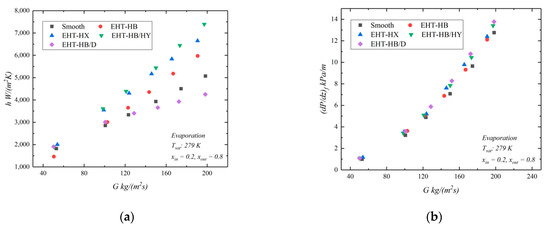
Figure 8.
Tubeside flow boiling performance comparison (using R410A) of heat transfer tubes as a function of mass flux (G) for: (a) condensation HTC and (b) pressure drop.
Variation of pressure drop with G during evaporation is given in Figure 8b; increase in pressure drop ranged from 4.1 to 9.7%. Considering the increase in heat transfer that is achieved (3.9% to 45.8%) the pressure drop increase is relatively low; therefore these tubes should be considered for evaporation applications. Highest performance was produced with the EHT—HB/HY tube; other tubes (i.e., EHT—HB/D) produced some increase to HTC but also produced slightly larger pressure drops. Hojati et al. [33] investigated the evaporating flow heat transfer characteristics inside a horizontal internally grooved tube. They determined that the grooved tube is 1.25 to 1.65 times higher than that of the smooth one. Current results are within the range of these results.
Evaporation flow patterns of the tubes tested (for inlet and outlet conditions) for G = 200 kg/(m2s) are given in Figure 9. As discussed previously for condensation, inlet flow patterns for all tubes are similar and are stratified wave flow. Nevertheless, the outlet flow patterns of the various tubes show a significant difference in appearance. The outlet flow patterns inside the plain, EHT—HB/HY and EHT—HB/D tubes are stratified wave flow; with the EHT—HB/D tube liquid level being the lowest. Semi-annular flow and annular flow are observed at the outlet of the EHT—HB and EHT—HX tubes; indicating that the micro-fin can create a liquid film and wet the upper part of the tube. Yang and Hrnjak [34] observed similar results. Yang and Hrnjak [35] furthered flow visualization works to study boing inside microfin tubes. They found that slug flow is present in the upper part of the tube with bubbles generated in a thin liquid area. Li and Hrnjak [36] studied heat transfer performance and flow pattern of R1234yf in a microchannel tube. They found that flow patterns was affected by mass flux and saturation pressure. Rashidi et al. [37] has studied methods to enhance evaporation and has studied performance enhancements in bundle boiling. This is an important next step to consider.

Figure 9.
Evaporation flow patterns for the tested tubes at the inlet and outlet (G = 200 kg/(m2s).
5. Conclusions
Tubeside evaporation and condensation HTCs and pressure drop data that varied with G was obtained and analysed when using R410A in smooth and enhanced tubes. Condensation evaluations were run at 318 K (saturation temperature) and for evaporation at 279 K. The effect of G was evaluated for a range of vapor qualities in the test section (0.2 to 0.8). Both the heat transfer coefficient and pressure drop were measured and analysed; additionally, visualizations of the flow patterns were recorded. The following conclusions are drawn from the results:
- -
- Highest condensation HTCs were exhibited in the EHT—HB/D tube. Initially the HTCs of the enhanced tubes initially decreased; then as G increased above 100 kg/(m2s), the HTC increased slightly. Enhanced surfaces evaluated in this study consisted of classic enhanced (HB and HX) and composite enhanced (HB/D and HB/HY) tubes. These enhancements produce drainage at the lower G values; moving liquid condensate at the groove tips (fins) to the bottom of the tube, producing an enhanced performance. Additionally, the HTCs of the EHT—HB/D flatten out with increasing G. The EHT—HB/D tube produces the largest increase to pressure drop during condensation (0–5.3%).
- -
- Similar evaporation HTCs are shown for the tubes at G = 50 kg/(m2s); indicating that at these conditions, enhanced surfaces are not very effective at low mass velocities. For G > 100 kg/(m2s), the EHT—HB/HY and EHT—HX tubes produced higher HTCs than the other enhanced tubes; when compared to a plain tube, the HTCs of the EHT—HB/HY and EHT—HX increase from 3.9 to 45.8%. Lowest evaporation performance is found in the EHT—HB/D tube, for many conditions its performance is worse than a plain tube; the dimples and herringbone grooves produce liquid entrainment that contributes to its poor performance.
- -
- Two-phase inlet and outlet flow patterns inside the five test tubes are observed; different flow patterns can influence the heat transfer performance.
- -
- Several condensation and evaporation correlations inside smooth tubes were compared. Cavallini et al. [25] produce a correlation with the best predictive ability for the condensation HTC; Liu and Winterton [29] accurately predicts the evaporation HTCs.
- -
- Two novel three-dimensional, composite, enhanced surfaces for use in condensation and evaporation applications have been introduced and studied in this investigation. Additional studies that optimize the surface configuration (i.e., height of enhancement structure, number of structures per unit area, geometric characteristics, etc.) need to be studied in more detail and are the topics of future investigations.
Author Contributions
Conceptualization, W.T. and D.J.K.; methodology, W.T. and R.S.; software, W.T., B.Z. and Y.G.; validation, W.T. and Y.G.; formal analysis, D.J.K., B.Z. and W.T.; investigation, W.T.; resources, D.J.K. and R.S.; data curation, W.T. and Z.S.; writing—original draft preparation, W.T.; writing—review and editing, D.J.K. and W.L.; visualization, W.T., J.W. and Z.S.; supervision, D.J.K., R.S. and W.L.; project administration, D.J.K. and W.L.; funding acquisition, D.J.K., R.S. and W.L. All authors have read and agreed to the published version of the manuscript.
Funding
This work is supported by the National Science Foundation of China (52076187).
Institutional Review Board Statement
Not applicable.
Informed Consent Statement
Not applicable.
Data Availability Statement
The pre-processed data used in this study are available on request from the corresponding author.
Conflicts of Interest
The authors declare no conflict of interest.
Nomenclature
| A | test tube surface area, m2 |
| C | enhancement ratio |
| cp | specific heat, J/(kg·K) |
| D | dimple |
| d | test tube diameter, m |
| dh | hydraulic diameter, m |
| EHT | enhanced |
| Fa | |
| f | Fanning friction factor |
| G | mass flux, kg/(m2s) |
| g | gravitational acceleration, m/s2 |
| HB | herringbone |
| HX | helix micro-fin |
| HY | hydrophobic |
| h | heat transfer coefficient, W/(m2·K) |
| hlv | latent heat of vaporization, J/kg |
| k | thermal conductivity, W/(m·K) |
| L | tube length, m |
| LMTD | logarithmic mean temperature, K |
| m | mass flux, kg/s |
| P | Pressure, kpa |
| PF | performance factor |
| Pr | Prandtl number |
| Q | heat transfer amount, W |
| q | heat flux, W/m2 |
| Re | Reynolds number |
| Sa | arithmetical mean height, mm |
| Sq | root mean square height, mm |
| Sp | maximum peak height, mm |
| Sv | maximum pit height, mm |
| Sz | maximum height, mm |
| Ssk | skewness |
| Sku | kurtosis |
| Spar | projected area, mm2 |
| Sdar | developed area, mm2 |
| T/t | temperature, K/°C |
| U | Total heat transfer coefficient, W/(m2K) |
| x | vapor quality |
| Greek symbols | |
| μ | dynamic viscosity, Pa·s |
| ρ | density, kg/m3 |
| ε | void fraction |
| σ | surface tension, N/m |
| ζ | area ratio |
| Subscripts | |
| bulk | bulk temperature |
| exp | experimental |
| f | frictional |
| g | gravitational |
| i | inner |
| in | inlet |
| l | liquid phase |
| lat | latent heat |
| m | momentum |
| o | outer |
| out | outlet |
| pre | predictive |
| ref | refrigerant |
| s | smooth |
| sat | saturated |
| sc | sudden contraction |
| se | sudden enlargement |
| sens | sensible heat |
| t | total |
| te | test section |
| tp | two-phase |
| ts | test section |
| v | vapor phase |
| wall | wall parameters |
| w | water |
References
- Webb, R.L.; Kim, N.-H. Principles of Enhanced Heat Transfer, 2nd ed.; Taylor & Francis: New York, NY, USA, 2005. [Google Scholar]
- Wang, Y.; He, Y.-L.; Lei, Y.-G.; Zhang, J. Heat transfer and hydrodynamics analysis of a novel dimpled tube. Exp. Therm. Fluid Sci. 2010, 34, 1273–1281. [Google Scholar] [CrossRef]
- Li, M.; Khan, T.S.; Al-Hajri, E.; Ayub, Z.H. Single phase heat transfer and pressure drop analysis of a dimpled enhanced tube. Appl. Therm. Eng. 2016, 101, 38–46. [Google Scholar] [CrossRef]
- Li, M.; Khan, T.S.; Al Hajri, E.; Ayub, Z.H. Geometric optimization for thermal–hydraulic performance of dimpled enhanced tubes for single phase flow. Appl. Therm. Eng. 2016, 103, 639–650. [Google Scholar] [CrossRef]
- Vicente, P.G.; García, A.; Viedma, A. Heat transfer and pressure drop for low Reynolds turbulent flow in helically dimpled tubes. Int. J. Heat Mass Transf. 2002, 45, 543–553. [Google Scholar] [CrossRef]
- Kukulka, D.J.; Smith, R. Thermal-hydraulic performance of Vipertex 1EHT enhanced heat transfer tubes. Appl. Therm. Eng. 2013, 61, 60–66. [Google Scholar] [CrossRef]
- Guo, S.P.; Wu, Z.; Li, W.; Kukulka, D.; Sunden, B.; Zhou, X.P.; Wei, J.J.; Simon, T. Condensation and evaporation heat transfer characteristics in horizontal smooth, herringbone and enhanced surface EHT tubes. Int. J. Heat Mass Transf. 2015, 85, 281–291. [Google Scholar] [CrossRef]
- Li, W.; Chen, J.; Zhu, H.; Kukulka, D.J.; Minkowycz, W.J. Experimental study on condensation and evaporation flow inside horizontal three dimensional enhanced tubes. Int. Commun. Heat Mass 2017, 80, 30–40. [Google Scholar] [CrossRef]
- Li, W.; Tang, W.; Chen, J.; Zhu, H.; Kukulka, D.J.; He, Y.; Sun, Z.; Du, J.; Zhang, B. Convective condensation in three enhanced tubes with different surface modifications. Exp. Therm. Fluid Sci. 2018, 97, 79–88. [Google Scholar] [CrossRef]
- Aroonrat, K.; Wongwises, S. Experimental study on two-phase condensation heat transfer and pressure drop of R-134a flowing in a dimpled tube. Int. J. Heat Mass Transf. 2017, 106, 437–448. [Google Scholar] [CrossRef]
- Aroonrat, K.; Wongwises, S. Condensation heat transfer and pressure drop characteristics of R-134a flowing through dimpled tubes with different helical and dimpled pitches. Int. J. Heat Mass Transf. 2018, 121, 620–631. [Google Scholar] [CrossRef]
- Sarmadian, A.; Shafaee, M.; Mashouf, H.; Mohseni, S.G. Condensation heat transfer and pressure drop characteristics of R-600a in horizontal smooth and helically dimpled tubes. Exp. Therm. Fluid Sci. 2017, 86, 54–62. [Google Scholar] [CrossRef]
- Shafaee, M.; Mashouf, H.; Sarmadian, A.; Mohseni, S.G. Evaporation heat transfer and pressure drop characteristics of R-600a in horizontal smooth and helically dimpled tubes. Appl. Therm. Eng. 2016, 107, 28–36. [Google Scholar] [CrossRef]
- Ayub, Z.H.; Ayub, A.H.; Ribatski, G.; Moreira, T.A.; Khan, T.S. Two-phase pressure drop and flow boiling heat transfer in an enhanced dimpled tube with a solid round rod insert. Int. J. Refrig. 2017, 75, 1–13. [Google Scholar] [CrossRef]
- Kukulka, D.; Smith, R. Comparison of Heat Exchanger Designs Using Vipertex 1EHT Enhanced Heat Transfer Tubes. Chem. Eng. Trans. 2016, 52, 115–120. [Google Scholar]
- Kukulka, D.J.; Smith, R. Experimental Comparison of the Evaporation and Condensation Heat Transfer Coefficients on the Outside of Enhanced Surface Tubes with Different Outer Diameters. Chem. Eng. Trans. 2019, 76, 31–36. [Google Scholar]
- Soontarapiromsook, J.; Mahian, O.; Selim Dalkilic, A.; Wongwises, S. Effect of surface roughness on the condensation of R-134a in vertical chevron gasketed plate heat exchangers. Exp. Therm. Fluid Sci. 2017, 91, 54–63. [Google Scholar] [CrossRef]
- Wang, Y.; Luo, J.; Heng, Y.; Mo, D.; Lyu, S. Wettability modification to further enhance the pool boiling performance of the micro nano bi-porous copper surface structure. Int. J. Heat Mass Transf. 2018, 119, 333–342. [Google Scholar] [CrossRef]
- Wu, Z.; Sunden, B.; Wang, L.; Li, W. Convective Condensation Inside Horizontal Smooth and Microfin Tubes. J. Heat Transf. 2014, 136, 98–99. [Google Scholar] [CrossRef]
- Gnielinski, V. New Equations for Heat and Mass Transfer in Turbulent Pipe and Channel Flow. Int. Chem. Eng. 1976, 16, 8–16. [Google Scholar]
- Petukhov, B.S. Heat Transfer and Friction in Turbulent Pipe Flow with Variable Physical Properties. Adv. Heat Transf. 1970, 6, 503–564. [Google Scholar]
- Rouhani, S.Z.; Axelsson, E. Calculation of void volume fraction in the subcooled and quality boiling regions. Int. J. Heat Mass Tran. 1970, 13, 383–393. [Google Scholar] [CrossRef]
- Moffat, R.J. Describing the uncertainties in experimental results. Exp. Therm. Fluid Sci. 1988, 1, 3–17. [Google Scholar] [CrossRef]
- Shah, M.M. A general correlation for heat transfer during film condensation inside tube. Int. J. Heat Mass Transf. 1979, 22, 547–556. [Google Scholar] [CrossRef]
- Cavallini, A.; Col, D.D.; Doretti, L.; Matkovic, M.; Rossetto, L.; Zilio, C.; Censi, G. Condensation in horizontal smooth tubes: A new heat transfer model for heat exchanger design. Heat Transf. Eng. 2006, 27, 31–38. [Google Scholar] [CrossRef]
- Haraguchi, H.; Koyama, S.; Fujii, T. Condensation of Refrigerants HCFC 22, HFC 134a and HCFC 123 in a Horizontal Smooth Tube (2nd Report, Proposals of Empirical Expressions for the Local Heat Transfer Coefficient). Trans. Jpn. Soc. Mech. Eng. Ser. B 1994, 60, 2117–2124. Available online: https://kyushu-u.pure.elsevier.com/en/publications/condensation-of-refrigerants-hcfc-22-hfc-134a-and-hcfc-123-in-a-h (accessed on 6 February 2021). [CrossRef]
- Li, G.-Q.; Wu, Z.; Li, W.; Wang, Z.-K.; Wang, X.; Li, H.-X.; Yao, S.-C. Experimental investigation of condensation in micro-fin tubes of different geometries. Exp. Therm. Fluid Sci. 2012, 37, 19–28. [Google Scholar] [CrossRef]
- Kedzierski, M.; Goncalves, J.M. Horizontal convective condensation of alternative refrigerants within a micro-fin tube. J. Enhanc. Heat Transf. 1999, 6, 161–178. [Google Scholar] [CrossRef]
- Diani, A.; Brunello, P.; Rossetto, L. R513A condensation heat transfer inside tubes: Microfin tube vs. smooth tube. Int. J. Heat Mass Transf. 2020, 152, 119472. [Google Scholar] [CrossRef]
- Liu, Z.; Winterton, R.H.S. A general correlation for saturated and subcooled flow boiling in tubes and annuli, based on a nucleate pool boiling equation. Int. J. Heat Mass Transf. 1991, 34, 2759–2766. [Google Scholar] [CrossRef]
- Fang, X. A new correlation of flow boiling heat transfer coefficients based on R134a data. Int. J. Heat Mass Transf. 2013, 66, 279–283. [Google Scholar] [CrossRef]
- Gungor, K.E.; Winterton, R.H.S. A general correlation for flow boiling in tubes and annuli. Int. J. Heat Mass Transf. 1986, 29, 351–358. [Google Scholar] [CrossRef]
- Hojati, A.; Akhavan-Behabadi, M.A.; Hanafizadeh, P.; Ahmadpour, M.M. An Experimental Investigation on R134a Evaporation inside an Internally Discrete Inclined Grooved Tube. Heat Transf. Eng. 2020. [Google Scholar] [CrossRef]
- Yang, C.; Hrnjak, P. Effect of helical micro-fins on two-phase flow behavior of R410A evaporating in horizontal round tubes obtained through visualization. Int. J. Heat Mass Transf. 2019, 144, 118654. [Google Scholar] [CrossRef]
- Yang, C.; Hrnjak, P. Diabatic visualization shows effects of micro-fins on evaporation of R410A: Smooth, axial micro-fin, and helical micro-fin tubes. Int. J. Heat Mass Transf. 2020, 150, 119276. [Google Scholar] [CrossRef]
- Li, H.; Hrnjak, P. Heat Transfer Coefficient, Pressure Gradient, and Flow Patterns of R1234yf Evaporating in Microchannel Tube. ASME J. Heat Transfer. 2021. [Google Scholar] [CrossRef]
- Rashidi, S.; Hormozi, F.; Sarafraz, M.M. Fundamental and subphenomena of boiling heat transfer. J. Therm. Anal. Calorim. 2020. [Google Scholar] [CrossRef]
Publisher’s Note: MDPI stays neutral with regard to jurisdictional claims in published maps and institutional affiliations. |
© 2021 by the authors. Licensee MDPI, Basel, Switzerland. This article is an open access article distributed under the terms and conditions of the Creative Commons Attribution (CC BY) license (http://creativecommons.org/licenses/by/4.0/).